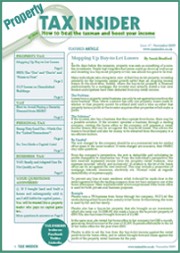Before you go, sign up to our free tax saving email course. Get 7 top property tax saving strategies in your email inbox that will help you save thousands in tax. Unsubscribe any time.
 A popular piece of tax planning for buy-to-let investors is to
move into a property and live in it for a few months before selling it,
thus attracting the exemption from CGT for a “main residence” for the
last three years of ownership, together with the “letting exemption” of
up to £40,000 per owner. A popular piece of tax planning for buy-to-let investors is to
move into a property and live in it for a few months before selling it,
thus attracting the exemption from CGT for a “main residence” for the
last three years of ownership, together with the “letting exemption” of
up to £40,000 per owner.
In the case of a property that has been owned for a number of years, and which has a large capital gain that will crystallise on sale, there may still be tax payable even after these reliefs have been claimed. Example Nick owns a buy-to-let (“BTL”) property which he bought in May 1993, and has let ever since. It cost him £125,000 and is now worth £350,000. If he and his wife (who does not own a share of the property) move into this property and live there for a year before selling it in May 2013, three-twentieths of the gain of £225,000 will be exempt from CGT, leaving £191,250 chargeable. After the £40,000 letting exemption and Nick’s annual exempt amount of £10,600, the taxable gain is still £140,650, meaning CGT payable of £39,382. A better way? In the right circumstances, it would be possible for Nick to avoid paying all this tax. A popular way to reduce the tax payable is for Nick to give his wife a half share in the property shortly before sale, thus bringing in her £10,600 annual exempt amount, but we can do better than this. A gift between a married couple or civil partners is deemed to occur on a “no gain, no loss” basis, but there is a specific rule relating to a gift of a main residence – not only does the spouse receiving the gift take over the giver’s base cost, she also takes over the history of ownership. If Nick were to give the property to his wife while they were living in it as their main residence, she would make exactly the same gain as he would and nothing would have been achieved. This does not apply to any other gifts, so what Nick needs to do is to give his wife the property while it is still being let. Say he makes the gift in May 2012, and he and his wife move into the property when the tenant leaves in July 2012. She sells the property in July 2013, after they have been living there for a year. Nick’s wife is deemed to have owned the property from May 2012, and at the time of the sale it is her and Nick’s main residence, so the whole period of her ownership is included in the exemption for the final three years of ownership, and there is no CGT to pay. Nick and his wife have another property that is their home, so it is important that when they start using the ex-BTL property as a residence, they make a “nomination” (i.e. under section 222(5) of the Taxation of Chargeable Gains Act) specifying that the ex-BTL property is to be treated as their main residence. As husband and wife, they both have to sign this, even though it is Mrs Nick who owns the property. It is not essential that they show that the BTL property is actually their “main” residence; simply that they can demonstrate they are using it as one of two residences. This is quite provocative tax planning, and Nick needs to get help from a good tax adviser to make sure he and his wife get the details right. Practical Tip :
HM Revenue and Customs cannot attack the basic planning which relies on the plain words of the legislation, but they can and will attack if the plan has been sloppily executed and details have been forgotten. This is a sample article from the monthly Property Tax Insider magazine. Go here to get your first free issue of Property Tax Insider. |


 Tax Articles
Tax Articles